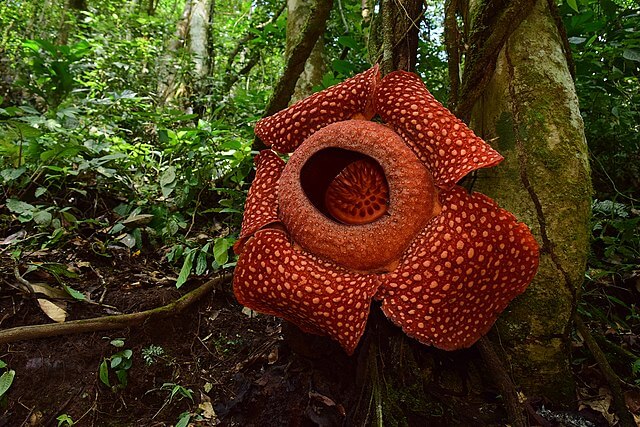
The enigmatic and parasitic Rafflesia, colloquially known as the corpse flower for its foul odor of decaying flesh, has long captivated botanists. Today, scientists are sounding the alarm about its risk of extinction, urging urgent action to preserve it.
Rafflesia, a genus that includes the world’s largest flowers, measuring over a meter in diameter, is under threat due to the widespread destruction of its forest habitats in Southeast Asia. This fascinating plant group consists of 42 species, and experts caution that all of them face endangerment, with 25 categorised as critically endangered and 15 as endangered.
According to a recent study published in the journal “Plants, People, Planet,” over two-thirds of these species are not adequately protected by existing conservation strategies. This study marks the first global assessment of the perils confronting Rafflesia plants.
Dr Chris Thorogood, from the University of Oxford Botanic Garden, an author of the study, said the study “highlights how the global conservation efforts geared towards plants – however iconic – have lagged behind those of animals”.
“We urgently need a joined-up, cross-regional approach to save some of the world’s most remarkable flowers, most of which are now on the brink of being lost,” he said.
These plants remain poorly understood because they largely remain hidden throughout their life cycle, with new species still being discovered. Many populations are believed to comprise just a few hundred individuals. “Alarmingly, recent observations suggest taxa are still being eradicated before they are even known to science,” researchers warn in the paper.
Rafflesia is a parasitic plant devoid of leaves, stems, and roots, incapable of photosynthesis. Instead, it employs long filaments that resemble fungal cells to extract nutrients and water from tropical jungle vines in regions including Brunei, Indonesia, Malaysia, the Philippines, and Thailand. Rafflesia remains concealed within the vine for most of its life but eventually produces a cabbage-like bud that blossoms into a giant rubbery flower. These unique flowers are pollinated through a thick, sticky substance that adheres to flies.
European explorers first encountered these plants in the late 18th century, spurring a fascination that led many expeditions to seek out or collect the flowers. Researchers were particularly intrigued by their connection to jungle vines.
Presently, only one species, Rafflesia magnifica, is classified as critically endangered by the International Union for the Conservation of Nature (IUCN). However, scientists advocate for the inclusion of all Rafflesia species on the IUCN Red List of Threatened Species.
They are urging stronger protections for Rafflesia habitats, a deeper comprehension of existing species, and innovative methods for propagation. Current attempts to cultivate Rafflesia in botanical gardens have met with limited success.
Furthermore, scientists are advocating for ecotourism initiatives to ensure local communities can derive benefits from Rafflesia conservation efforts. This approach aims to create incentives for safeguarding these unique plants and their environments.
“Indigenous peoples are some of the best guardians of our forests, and Rafflesia conservation programmes are far more likely to be successful if they engage local communities,” Adriane Tobias, a forester from the Philippines, said. “Rafflesia has the potential to be a new icon for conservation in the Asian tropics.”
——————————————————————————
At Natural World Fund, we are passionate about stopping the decline in our wildlife.
The decline in our wildlife is shocking and frightening. Without much more support, many of the animals we know and love will continue in their decline towards extinction.
When you help to restore a patch of degraded land through rewilding to forests, meadows, or wetlands, you have a massive impact on the biodiversity at a local level. You give animals a home and food that they otherwise would not have had, and it has a positive snowball effect on the food chain.
We are convinced that this is much better for the UK than growing lots of fast-growing coniferous trees, solely to remove carbon, that don’t actually help our animals to thrive.
This is why we stand for restoring nature in the UK through responsible rewilding. For us, it is the right thing to do. Let’s do what’s right for nature!
Donate today at https://naturalworldfund.com/ and join in the solution!

